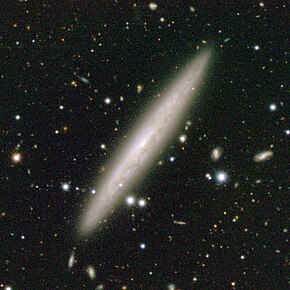
KNOWPIA
WELCOME TO KNOWPIA
Summary
NGC 360 is a spiral galaxy located approximately 103 million light-years from the Solar System[2] in the constellation Tucana. It was discovered on 2 November 1834 by John Herschel. Dreyer, creator of the New General Catalogue described the object as "extremely faint, very much extended 145°, very little brighter middle."[4]
| NGC 360 | |
|---|---|
 NGC 360 as seen by DECam | |
| Observation data (J2000 epoch) | |
| Constellation | Tucana |
| Right ascension | 01h 02m 51.4s[1] |
| Declination | −65° 36′ 36″[1] |
| Redshift | 0.007693[1] |
| Heliocentric radial velocity | 2,306 km/s[1] |
| Distance | 103 Mly[2] |
| Apparent magnitude (V) | 13.40[1] |
| Apparent magnitude (B) | 13.4[3] |
| Characteristics | |
| Type | Sbc[1] |
| Apparent size (V) | 4.03' × 0.52'[1] |
| Other designations | |
| ESO 079- G 014, 2MASX J01025144-6536359, IRAS 01009-6552, F01009-6552, ESO-LV 0790140, 6dF J0102515-653636, PGC 3743.[1] | |
See also edit
References edit
- ^ a b c d e f g h "NASA/IPAC Extragalactic Database". Results for NGC 0360. Retrieved September 2, 2016.
- ^ a b An object's distance from Earth can be determined using Hubble's law: v=Ho is Hubble's constant (70±5 (km/s)/Mpc). The relative uncertainty Δd/d divided by the distance is equal to the sum of the relative uncertainties of the velocity and v=Ho
- ^ "Revised NGC Data for NGC 360". spider.seds.org. Retrieved December 9, 2017.
- ^ "New General Catalog Objects: NGC 350 - 399". Cseligman. Retrieved November 19, 2016.
External links edit
- Media related to NGC 360 at Wikimedia Commons
- NGC 360 on WikiSky: DSS2, SDSS, GALEX, IRAS, Hydrogen α, X-Ray, Astrophoto, Sky Map, Articles and images
- SEDS


